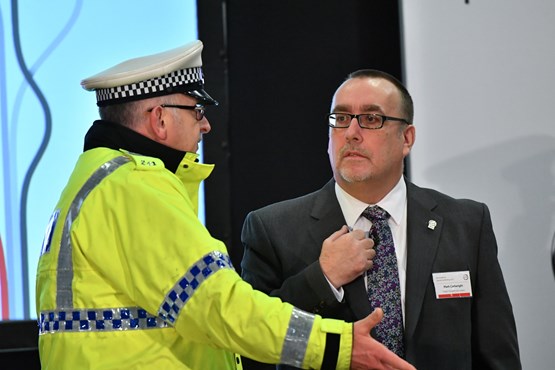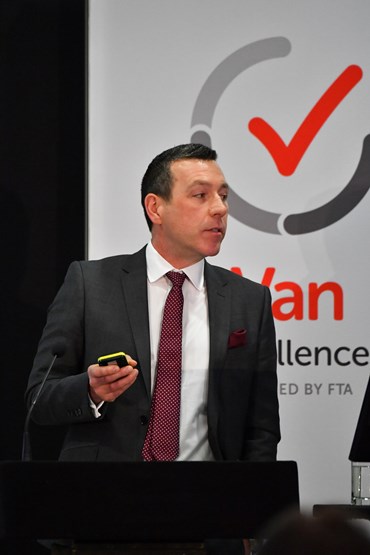The FTA staged a road fatality at the annual Van Excellence conference giving delegates food for thought about culpability.
If one of your vehicles was involved in a collision with a pedestrian are you confident you are legally protected? That was the question the Freight Transport Association (FTA) wanted to highlight at its annual Van Excellence conference.
The day started with a staged interruption of the conference by a police officer coming to inform the group that one of their vehicles had knocked down an 11-year-old girl.
Delegates were then shown videos of the journey through the investigation process which culminated in a live mock-courtroom scene. The scenario was based on a number of real-life cases.

The first scene was a police interview with the driver. Before it began the police officer informed the driver that the person he hit had died. It was clear from the investigation that a number of factors had contributed to the incident such as vehicle defects, mobile phone use and intoxication.
But the driver blamed his long working hours as a gas engineer, constant interruption from his manager and the company’s focus on ‘getting the job done’ as the reasons behind his actions.
The operations manager was then interrogated. He had put best practice procedures in place, such as daily checks, hands-free kits and driving policies. However, he had not been following up on the reports and had let things slide. The vehicle involved was reported to have bald tyres, no washer fluid and a broken hands-free kit. The operations manager blamed this on his increasing workload and a lack of transparency over his role.
Finally the company’s managing director was called for interview. He was the business O-licence holder but, as it transpired, only from a paperwork point of view. He also claimed that vans are “just vans” and didn’t need regular attention like his heavier vehicles. When the police officer asked if the company provided driver training, he replied “no, they’re gas engineers”.
In the final session of the day the three participants were sentenced at a mock trial.
Their “punishments” were as follows: the driver was jailed for four years and in addition was disqualified from driving for four years extended to begin at the end of the jail term, plus a 12-month supervision order; the operations manager was handed a 12-month community order and told to carry out 200 hours of unpaid work; the managing director was fined £250,000.
The activity served to highlight how easy it is for fleets to overlook basic compliance requirements and how they can escalate to the point where somebody – in this instance, the driver – ends up in jail.
Strategies for managing drivers and reducing risk
Driver training specialist Sandra MacDonald-Ames spoke on behalf of Gallagher Bassett to highlight the importance of risk profiling drivers.
She said: “For too long driver training has focused on the wrong things. If a driver has a collision, we assume it’s because of a skills deficit and not due to distraction.”
Creating a risk profile of each driver will highlight those who have poor skills and those who have poor behaviour. The key element is to consider aspects of the job that will affect driving performance like fatigue and stress alongside aspects of the driver’s personality such as how they react to situations.
According to MacDonald-Ames, fleets have become reliant on telematics to keep drivers in check, but the systems only tell part of the story.
“If a driver gets bad scores they are often sent for more training but there is a difference between an unsafe driver and one who just has a rough driving style,” she explained.

Protecting against drug-driving
Claire Hopper, sales and training manager at AlcoDigital, went over the drug-driving laws that were introduced in March 2015.
The previous offence was driving while impaired by drugs and the police had to prove the drugs caused the impairment. Under the new law the police only need to obtain a blood sample which proves certain drugs are present and above specified limits.
Hopper told delegates the importance of checking what medication their drivers are on as some prescription medicines are now restricted under the new law.
“Drivers can still work, they just need to make sure they carry a prescription to prove they are allowed the drugs,” she said.
Since the new guidelines were introduced more than 8,000 drivers have been arrested with 98% convicted for the offence of drug-driving.
“You have a duty of care, drug drivers are still on the road,” Hopper warned.
She told delegates to perform regular drug testing and ensure their fleet policy clearly states there is a ‘zero-tolerance’ policy on the use of illegal drugs.
Cut down the distractions
Driver behaviour expert Lisa Dorn presented some insight from her research into what distracts drivers.
The associate professor at Cranfield University said: “Time pressure is the number one reason why commercial drivers are more likely to be in crashes. When you compare their driving at work to leisure that’s where the driving changes. The real difference is the pressure.”
Delegates were told how hazard perception training has been developed from research into how we use our eyes when driving. Dorn said younger drivers have a more narrow scope and spend longer looking at hazards.
She went on to explain what happens when a mobile phone is introduced to the mix: “Response times are much slower and drivers don’t compensate by leaving greater headway.
“You’re not in the same visual space as the person you are talking to so they can’t see how demanding it is for you to drive in that situation, unlike a passenger.”
Dorn added that drivers generally have a biased opinion of their driving ability. Because traffic is very forgiving, mistakes are often allowed for by other drivers reacting which leads to overconfidence.
Managing driver health issues
Eamonn Brennan, manager – van information at FTA, introduced some best practice guidelines for ensuring drivers are fit to work.
He recommended all fleets start to carry out eye tests at the same time as licence checks, if they don’t already.
“It’s very simple. You just need to ask the driver to read a number plate from 20 metres,” explained Brennan.
Drivers also need to be aware of the impact a medical issue can have on their ability to drive.
“When learning to drive we think the process through but eventually it becomes muscle memory – how many times do you change gear without even thinking about it?
“A medical condition that impairs even a small part of the body can affect the cycle that drivers use all day long,” said Brennan.
He advised fleets that alongside a signed health declaration from all drivers at induction, they should get that document re-signed on a regular basis to remind the driver of their obligations.

How to influence attitudes and behaviour
Colin Knight (pictured), road risk manager at The Clancy Group, told delegates how his organisation has worked to reduce the number of collisions involving its drivers.
He explained that driver behaviour is about more than just telematics data and recommended that fleet operators look at their financial data to find potential risks.
Insurance claims are another area to investigate, along with the use of consumables such as brake pads and tyres. Knight said drivers who wear parts out more regularly and are often involved in scuffs and scrapes should be an immediate concern.
But he added: “Even if you do have all the paperwork in place, it won’t stop the crash from happening.”
According to Knight, driver training doesn’t go deep enough and managers need to be aware that driver attitude and behaviour have a large part to play.
“You have to create a sense of accountability from an early age. If a driver thinks they can get away with breaking the rules they will,” he said.





















Sage & Onion - 15/06/2017 13:35
One Fateful Day is a very good series of videos by the FTA to show this mock incident and highlights all the gaps that contributed to the accident. Its a good training tool that I intend to use.